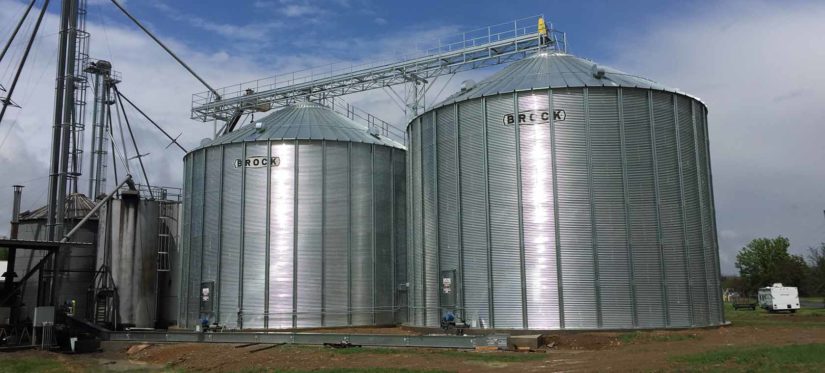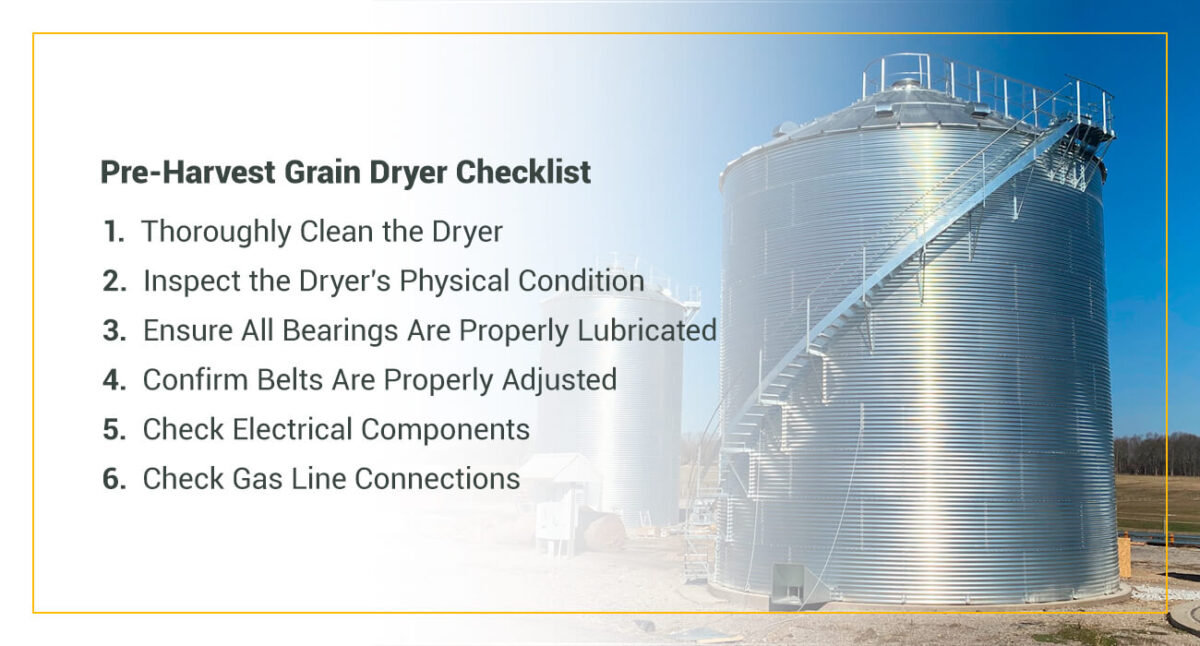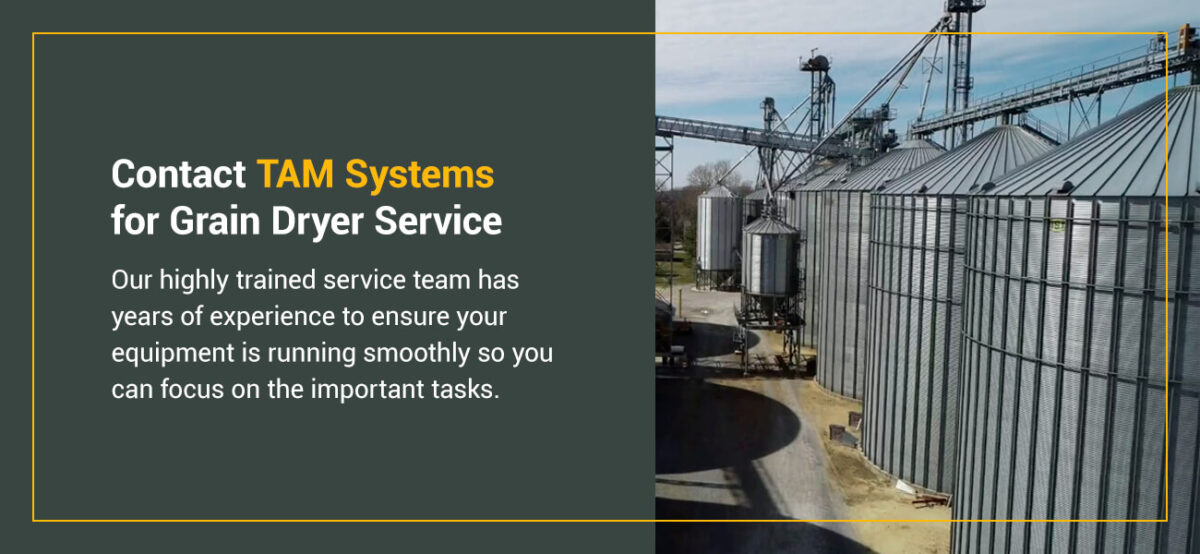Maintenance is essential to preserving the lifespan of any piece of machinery or equipment. Performing routine maintenance, following a maintenance schedule and preparing equipment prior to the harvesting season will help reduce the chance of equipment problems and failure. Ensuring that your equipment is in good condition before use will help prevent the need for repairs in the middle of harvesting, which will often result in delays.
Learn how to prepare your grain dryer for the upcoming season to prevent equipment damage and repair-related setbacks with the tips and checklist below.
Tips for Pre-Harvest Preparations
Pre-harvest preparations begin months before the harvesting season because there are many factors that contribute to the success of your crops and equipment. When it comes to your grain-drying equipment, pre-season maintenance and inspection should be at the top of your to-do list. Even if you performed quality clean-up and post-season repairs at the end of last year’s season, downtime can still take a toll on farm equipment.
Dust, debris and foreign objects may remain in the dryer from last season or find their way into the dryer during the off-season. Rodents and other pests may choose to take shelter in your equipment during cold months or bad weather. Engine oil can go bad during downtime, while belts, bearings and seals can dry out and crack over time. Taking the necessary preparations several months prior to starting your harvest gives you ample time to inspect, clean, repair and do any necessary grain dryer troubleshooting.
Pre-Harvest Grain Dryer Checklist
With so many parts to check and preventative steps to take, it can be a challenge to keep track of everything that needs doing. Proper maintenance is a crucial step in helping to ensure your grain-drying equipment is working at optimal energy efficiency levels. Use the following grain-drying energy efficiency checklist to ensure you do a thorough inspection and perform all necessary maintenance on your grain dryer.
For your safety, wear proper respiratory protection and safety glasses when servicing your grain dryer. High amounts of dust and dirt can be hazardous.
1. Thoroughly Clean the Dryer
Even if you took the time to clean out your grain dryer after the last harvest, it’s best to take some time to clean it again. If the equipment is still dirty from the last use, a thorough pre-season clean is imperative, especially if it’s been out of use for a long time. Clean both the inside and outside, as well as anywhere dust and grain can accumulate, like the hopper divider floor, unloading belts or augers, grain exchangers and under the roof.
Dust and debris can block airflow and affect the dryer’s ability to operate, so removing as much as possible is highly beneficial. Spraying water can help to remove dirt, as long as you are careful with water around electrical components like control boxes. You can spray down the screens with high-pressure water to remove dust build-up, which can be a fire hazard.
2. Inspect the Dryer’s Physical Condition
While you’re cleaning your equipment, take the opportunity to inspect the overall condition of the grain dryer’s interior and exterior. Check for rips in the siding as well as damage to the inner and outer skin. Look for missing bolts or other parts and replace them before operation. Also, inspect for excessive wear and rust so you can be sure to repair it before the damage gets worse.
This inspection should also involve checking that all ladders and platforms are safe to operate. Make sure all doors close tightly and seal properly for future use.
3. Ensure All Bearings Are Properly Lubricated
After your equipment is clean, properly lubricate all the bearings. If applicable, remove relief plugs prior to greasing. If your dryer does have relief plugs, be careful not to over-lubricate them. Too much grease can damage the seals and cause equipment failure. While you are lubricating the bearings, also lightly grease areas of the dryer that are prone to wear and rust after cleaning. Inspect and lubricate other parts like chains, U-joints and augers.
4. Confirm Belts Are Properly Adjusted
During downtime, belts may lose the proper tension they require to operate safely. Adjust the belts so you can push them down by one belt-width halfway between the pulleys. Ensure all belts are aligned properly so they will stay on the pulleys during operation. Check the condition of the belts in your grain dryer. If they show excessive wear, replace them before using the equipment to prevent further damage to the belts or potential damage to other parts of the machine.
5. Check Electrical Components
You should always keep electrical components and control boxes as clean and dry as possible. Physical damage to these parts of the machine will require repair for proper operation. Ensure all wiring connections are tight to help prevent overheating or other operational issues. Mice and other rodents may invade and chew on wires, so make sure to cover and protect all wiring. Open the control boxes to carefully clean the insides. If cleaning these areas is difficult, try using a vacuum, soft brush or compressed air.
6. Check Gas Line Connections
The gas line connections and other components need an inspection for leaks and to ensure the connections are tight. To check for leaks, spray the connection areas with a solution of water and dish soap. The appearance of small bubbles will reveal where the leaks are. Clean all supply lines, burners and vaporizers so there is no dust or debris that can cause damage.
For maintenance to be the most effective, it should occur before the harvest season, routinely during operation and after the season ends. Doing so will help prevent extensive damage and costly repairs.
Contact TAM Systems for Grain Dryer Service
While some farmers may be able to handle much of the pre-harvest preparations, inspections and maintenance processes themselves, you should take grain dryer repair and maintenance seriously to ensure a successful harvesting season. Many grain dryer manufacturers, like TAM Systems, offer ongoing maintenance services on their products. Having a professional grain dryer service take care of your pre-season maintenance is extremely beneficial.
At TAM services, we understand that you have numerous pre-harvest preparations to tend to, so let us take grain dryer maintenance and repair off your hands. Our highly trained service team has years of experience to ensure your equipment is running smoothly so you can focus on the important tasks. If you have any questions about our products and services or want help with pre-season maintenance, contact our professionals today!




